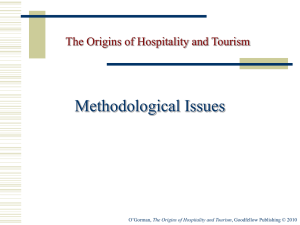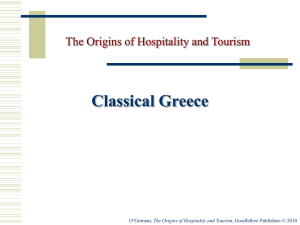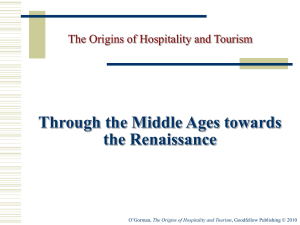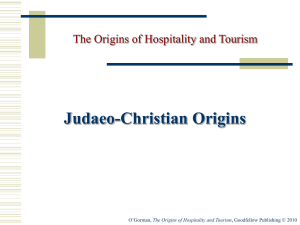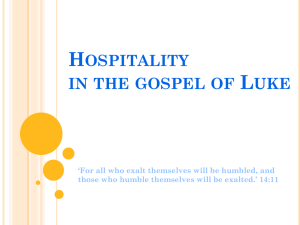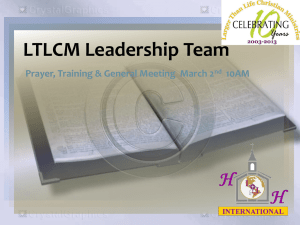Charitable Hospitality - Goodfellow Publishers
advertisement
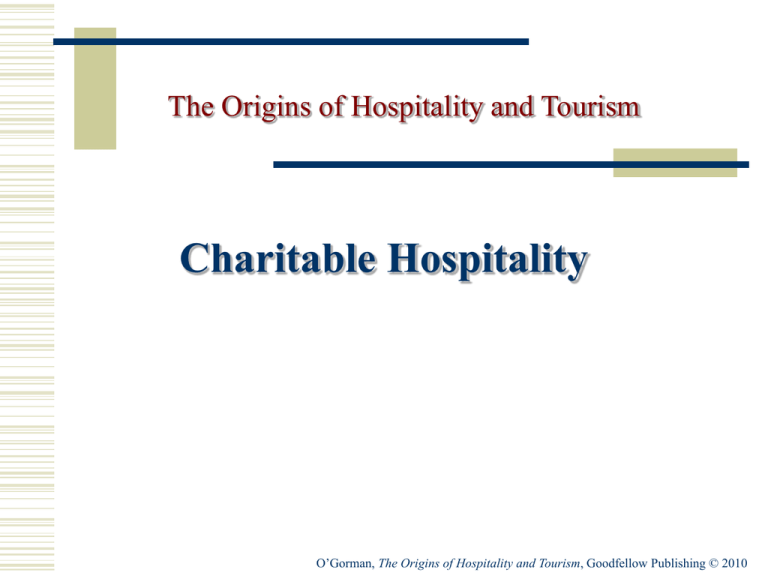
The Origins of Hospitality and Tourism Charitable Hospitality O’Gorman, The Origins of Hospitality and Tourism, Goodfellow Publishing © 2010 THE ABRAHAMIC MODEL OF HOSPITALITY O’Gorman, The Origins of Hospitality and Tourism, Goodfellow Publishing © 2010 “He (Abraham) looked up, and there he saw three men standing near him. As soon as he saw them, he ran from the entrance of the tent to greet them, and bowed to the ground. ‘My lord,’ he said, ‘if I find favour with you, please do not pass your servant by. Let me have a little water brought, and you can wash your feet and have a rest under the tree. Let me fetch a little bread and you can refresh yourselves before going further, now that you have come in your servant’s direction. They replied, ‘Do as you say’. Abraham hurried to the tent and said to Sarah, ‘Quick, knead three measures of best flour and make loaves.’ Then, running to the herd, Abraham took a fine and tender calf and gave it to the servant, who hurried to prepare it. Then taking curds, milk and the calf which had been prepared, he laid all before them, and they ate while he remained standing near them under the tree.” (Genesis 18:2-8) O’Gorman, The Origins of Hospitality and Tourism, Goodfellow Publishing © 2010 Hospitality of Abraham In the story of Abraham, there is the classic hospitality event. Abraham saw three simple nomads in the distance, he ran towards them to offer his hospitality. When he ‘bowed to the ground’, he was not making a gesture of religious adoration, but simply a mark of respect. At first, Abraham sees his guests as humans, as their superhuman character is only gradually revealed. He welcomes them warmly and invites them into his tent, to rest a bit and to eat a little. When they followed him home, however, Abraham had a full course banquet prepared for them. Yet as great as Abraham’s hospitality might have been, he had to contend with a society that was literally the antithesis of everything he represented. O’Gorman, The Origins of Hospitality and Tourism, Goodfellow Publishing © 2010 Hospitality and Society Cities of Sodom and Gomorrah were infamous for their cruelty and greed. When the angels journeyed to Sodom and Gomorrah, in search of a righteous man, only Lot and his family were set apart to be saved. Lot was deemed righteous, by the fact that he alone imitated Abraham’s behaviour of hospitality O’Gorman, The Origins of Hospitality and Tourism, Goodfellow Publishing © 2010 Hospitality and Society cont’d Numerous legends about Sodom and Gomorrah: In relation to hospitality, there is the legend: The people of the city had a special bed which they would offer to guests. When the guests were too tall for the bed, they would cut off their feet and when they were too short, they would stretch their limbs According to another legend, their ruins lay under the brackish waters of the Dead Sea; to the Arabs, the Sea of Lot, was raised up by the Creator to engulf these perverse cities. O’Gorman, The Origins of Hospitality and Tourism, Goodfellow Publishing © 2010 Evolution of Charitable Hospitality Emperor Julian when attempting to suppress the Christian faith, emphasised the importance of preserving and adapting for use by the state the Christian institutions of charitable hospitality. Emperor Justinian had been forced to give legal status to beggars and travellers because of the protection that they received through the same institutions of hospitality. O’Gorman, The Origins of Hospitality and Tourism, Goodfellow Publishing © 2010 Evolution of Charitable Hospitality cont’d The Protestant reformers of the Late Middle Ages moved them out of religious control into the secular realm of society just as Julian had attempted to do 1100 years earlier. In the early stages, any medical treatment was hard to come by as the old xenodochia were converted into monastic houses that only treated their own. As the Arab-Islamic influences became more recognised in the West, medicine advanced further with the importance of anatomy and surgery becoming more apparent. O’Gorman, The Origins of Hospitality and Tourism, Goodfellow Publishing © 2010 HOSPITALITY TO THOSE IN NECESSITUDINE Case Study: The Mungo Foundation Further Reading: O'Gorman, Kevin D. and Conti, Archbishop M.J. and McAlpine, D. (2008) Hospitality in necessitudine: hospices, hostels and hospitals. Hospitality Review, 10 (2). pp. 28-35. http://strathprints.strath.ac.uk/6393/1/strathprints00 6393.pdf For full details of the project: http://www.themungofoundation.org.uk/ O’Gorman, The Origins of Hospitality and Tourism, Goodfellow Publishing © 2010 The Mungo Foundation: Overview Established by the Archbishop of Glasgow in 2002 with a mission to “… to promote welfare, relieve poverty and advance education for the public benefit by the provision of wide-ranging social services” Run by a Board of Trustees, an operational staff of around 700, income of approximately £14m p.a. Supports over 1,000 people in its community based care and support services Responsible for own marketing and fundraising strategies Depends on the efforts of staff, volunteers and families who raise funds to support local work. Depends on donations from the wider community and remains committed to its founding values of life, justice and community. Much of the work of The Foundation in Scotland is now funded by local authorities. O’Gorman, The Origins of Hospitality and Tourism, Goodfellow Publishing © 2010 The Mungo Foundation: Operational Areas Supports people of all creeds and none with a wide variety of issues: Learning disabilities Sensory impairment Dementia People affected by drug and alcohol misuse People with a Mental Health Problem Young homeless people Asylum seekers Refugees Older People Young Single Mothers O’Gorman, The Origins of Hospitality and Tourism, Goodfellow Publishing © 2010 Hospitality Projects? Name Stravaig Purpose of the Project Immediate access to a safe environment to young homeless people with chaotic lives Annandale Offers support to older people with mental Street problems (other than dementia) Red Tower Provides a 12-month programme for those suffering with drug abuse to gain recovery (different from other projects as people contribute to the cost of treatment) O’Gorman, The Origins of Hospitality and Tourism, Goodfellow Publishing © 2010 THE EVOLVING BUT UNCHANGED ESSENCE OF CHARITABLE HOSPITALITY O’Gorman, The Origins of Hospitality and Tourism, Goodfellow Publishing © 2010 Evolving but unchanging Even when religion is attacked there has always been recognition of the importance of hospitality in necessitudine. Recently, instead of trying to subsume charitable hospitality, governments generally chose to support and partially fund the religious efforts. The influence of the underpinning ethos remains, even although the governance of the institutions may have changed. Despite the continually evolving practice, the Abrahamic Model of Hospitality, and St Paul’s mandate of hospitable behaviour, is still being interpreted and followed. As people’s needs continue to change, it remains the various religion faiths and orders, and now for society in general, to care for those needs in a practical and compassionate manner. O’Gorman, The Origins of Hospitality and Tourism, Goodfellow Publishing © 2010 Your thoughts… Are we as hospitality professionals interested in this area… Hospitality management graduates… role to play? How could we with our skills and knowledge base help to support this type of work? What do we need to learn? O’Gorman, The Origins of Hospitality and Tourism, Goodfellow Publishing © 2010 Further Reading O'Gorman, Kevin D. and Conti, Archbishop M.J. and McAlpine, D. (2008) Hospitality in necessitudine: hospices, hostels and hospitals. Hospitality Review, 10 (2). pp. 28-35. http://strathprints.strath.ac.uk/6393/1/strathprints00 6393.pdf O’Gorman, The Origins of Hospitality and Tourism, Goodfellow Publishing © 2010
